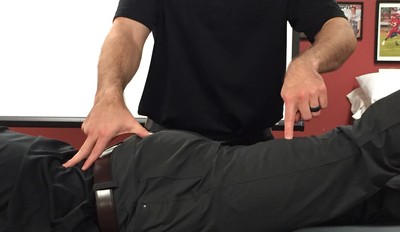- Home
- About Us
- TSPT Academy
- Online Courses
-
Resources
- Newsletter
- Business Minded Sports Physio Podcast
- Day in the Life of a Sports PT
- Residency Corner
-
Special Tests
>
-
Cervical Spine
>
- Alar Ligament Test
- Bakody's Sign
- Cervical Distraction Test
- Cervical Rotation Lateral Flexion Test
- Craniocervical Flexion Test (CCFT)
- Deep Neck Flexor Endurance Test
- Posterior-Anterior Segmental Mobility
- Segmental Mobility
- Sharp-Purser Test
- Spurling's Maneuver
- Transverse Ligament Test
- ULNT - Median
- ULNT - Radial
- ULNT - Ulnar
- Vertebral Artery Test
- Thoracic Spine >
-
Lumbar Spine/Sacroiliac Joint
>
- Active Sit-Up Test
- Alternate Gillet Test
- Crossed Straight Leg Raise Test
- Extensor Endurance Test
- FABER Test
- Fortin's Sign
- Gaenslen Test
- Gillet Test
- Gower's Sign
- Lumbar Quadrant Test
- POSH Test
- Posteroanterior Mobility
- Prone Knee Bend Test
- Prone Instability Test
- Resisted Abduction Test
- Sacral Clearing Test
- Seated Forward Flexion Test
- SIJ Compression/Distraction Test
- Slump Test
- Sphinx Test
- Spine Rotators & Multifidus Test
- Squish Test
- Standing Forward Flexion Test
- Straight Leg Raise Test
- Supine to Long Sit Test
-
Shoulder
>
- Active Compression Test
- Anterior Apprehension
- Biceps Load Test II
- Drop Arm Sign
- External Rotation Lag Sign
- Hawkins-Kennedy Impingement Sign
- Horizontal Adduction Test
- Internal Rotation Lag Sign
- Jobe Test
- Ludington's Test
- Neer Test
- Painful Arc Sign
- Pronated Load Test
- Resisted Supination External Rotation Test
- Speed's Test
- Posterior Apprehension
- Sulcus Sign
- Thoracic Outlet Tests >
- Yergason's Test
- Elbow >
- Wrist/Hand >
- Hip >
- Knee >
- Foot/Ankle >
-
Cervical Spine
>
- I want Financial Freedom
- I want Professional Growth
- I want Clinical Mastery
Hip Quadrant Test
Purpose: To determine if the hip is the source of the patient's symptoms.
Test Position: Supine.
Performing the Test: The affected limb is placed in adduction and a compression force is applied and maintained through the femur through a range of 70-140 degrees of hip flexion. The test is repeated in abduction. A positive test is a reproduction of the patient's worst pain that they came with into the clinic.
Diagnostic Accuracy: Sensitivity: .75; Specificity: .43; -LR: .58; +LR: 1.32 ("A preliminary report on prevlance of acetabular labral tears in sports patients with groin pain").
Importance of Test: This test works by scouring the femoral acetabular joint for pathology. The compression of the femur, through the various ranges, stresses the bone, labrum, cartilage, ligaments, etc. While this test has been labeled as the "hip clearing test," due to the low diagnostic accuracy, it should not necessarily be used as such. Consider the results of the rest of your exam when trying to determine the pathology.
Note: these tests should only be used by properly trained health care practitioners.
Test Position: Supine.
Performing the Test: The affected limb is placed in adduction and a compression force is applied and maintained through the femur through a range of 70-140 degrees of hip flexion. The test is repeated in abduction. A positive test is a reproduction of the patient's worst pain that they came with into the clinic.
Diagnostic Accuracy: Sensitivity: .75; Specificity: .43; -LR: .58; +LR: 1.32 ("A preliminary report on prevlance of acetabular labral tears in sports patients with groin pain").
Importance of Test: This test works by scouring the femoral acetabular joint for pathology. The compression of the femur, through the various ranges, stresses the bone, labrum, cartilage, ligaments, etc. While this test has been labeled as the "hip clearing test," due to the low diagnostic accuracy, it should not necessarily be used as such. Consider the results of the rest of your exam when trying to determine the pathology.
Note: these tests should only be used by properly trained health care practitioners.
Reference:
Narvani A, Tsirdis E, Kendall S, Chaudhuri R, Thomas P. "A preliminary report on prevalence of acetabular labral tears in sports patients with groin pain." Knee Surg Sports Traumatol Arthrosc 2003; 11:403-408. Web. 08/25/2012.
Narvani A, Tsirdis E, Kendall S, Chaudhuri R, Thomas P. "A preliminary report on prevalence of acetabular labral tears in sports patients with groin pain." Knee Surg Sports Traumatol Arthrosc 2003; 11:403-408. Web. 08/25/2012.
Copyright © The Student Physical Therapist LLC 2023




